Alex Pentland
Accelerating AI Development with Cyber Arenas
Sep 10, 2025Abstract:AI development requires high fidelity testing environments to effectively transition from the laboratory to operations. The flexibility offered by cyber arenas presents a novel opportunity to test new artificial intelligence (AI) capabilities with users. Cyber arenas are designed to expose end-users to real-world situations and must rapidly incorporate evolving capabilities to meet their core objectives. To explore this concept the MIT/IEEE/Amazon Graph Challenge Anonymized Network Sensor was deployed in a cyber arena during a National Guard exercise.
Amplifying Human Creativity and Problem Solving with AI Through Generative Collective Intelligence
May 25, 2025Abstract:We propose a new framework for human-AI collaboration that amplifies the distinct capabilities of both. This framework, which we call Generative Collective Intelligence (GCI), shifts AI to the group/social level and employs AI in dual roles: as interactive agents and as technology that accumulates, organizes, and leverages knowledge. By creating a cognitive bridge between human reasoning and AI models, GCI can overcome the limitations of purely algorithmic approaches to problem-solving and decision-making. The framework demonstrates how AI can be reframed as a social and cultural technology that enables groups to solve complex problems through structured collaboration that transcends traditional communication barriers. We describe the mathematical foundations of GCI based on comparative judgment and minimum regret principles, and illustrate its applications across domains including climate adaptation, healthcare transformation, and civic participation. By combining human creativity with AI's computational capabilities, GCI offers a promising approach to addressing complex societal challenges that neither human or machines can solve alone.
Authenticated Delegation and Authorized AI Agents
Jan 16, 2025



Abstract:The rapid deployment of autonomous AI agents creates urgent challenges around authorization, accountability, and access control in digital spaces. New standards are needed to know whom AI agents act on behalf of and guide their use appropriately, protecting online spaces while unlocking the value of task delegation to autonomous agents. We introduce a novel framework for authenticated, authorized, and auditable delegation of authority to AI agents, where human users can securely delegate and restrict the permissions and scope of agents while maintaining clear chains of accountability. This framework builds on existing identification and access management protocols, extending OAuth 2.0 and OpenID Connect with agent-specific credentials and metadata, maintaining compatibility with established authentication and web infrastructure. Further, we propose a framework for translating flexible, natural language permissions into auditable access control configurations, enabling robust scoping of AI agent capabilities across diverse interaction modalities. Taken together, this practical approach facilitates immediate deployment of AI agents while addressing key security and accountability concerns, working toward ensuring agentic AI systems perform only appropriate actions and providing a tool for digital service providers to enable AI agent interactions without risking harm from scalable interaction.
Bridging the Data Provenance Gap Across Text, Speech and Video
Dec 19, 2024



Abstract:Progress in AI is driven largely by the scale and quality of training data. Despite this, there is a deficit of empirical analysis examining the attributes of well-established datasets beyond text. In this work we conduct the largest and first-of-its-kind longitudinal audit across modalities--popular text, speech, and video datasets--from their detailed sourcing trends and use restrictions to their geographical and linguistic representation. Our manual analysis covers nearly 4000 public datasets between 1990-2024, spanning 608 languages, 798 sources, 659 organizations, and 67 countries. We find that multimodal machine learning applications have overwhelmingly turned to web-crawled, synthetic, and social media platforms, such as YouTube, for their training sets, eclipsing all other sources since 2019. Secondly, tracing the chain of dataset derivations we find that while less than 33% of datasets are restrictively licensed, over 80% of the source content in widely-used text, speech, and video datasets, carry non-commercial restrictions. Finally, counter to the rising number of languages and geographies represented in public AI training datasets, our audit demonstrates measures of relative geographical and multilingual representation have failed to significantly improve their coverage since 2013. We believe the breadth of our audit enables us to empirically examine trends in data sourcing, restrictions, and Western-centricity at an ecosystem-level, and that visibility into these questions are essential to progress in responsible AI. As a contribution to ongoing improvements in dataset transparency and responsible use, we release our entire multimodal audit, allowing practitioners to trace data provenance across text, speech, and video.
Don't forget private retrieval: distributed private similarity search for large language models
Nov 21, 2023Abstract:While the flexible capabilities of large language models (LLMs) allow them to answer a range of queries based on existing learned knowledge, information retrieval to augment generation is an important tool to allow LLMs to answer questions on information not included in pre-training data. Such private information is increasingly being generated in a wide array of distributed contexts by organizations and individuals. Performing such information retrieval using neural embeddings of queries and documents always leaked information about queries and database content unless both were stored locally. We present Private Retrieval Augmented Generation (PRAG), an approach that uses multi-party computation (MPC) to securely transmit queries to a distributed set of servers containing a privately constructed database to return top-k and approximate top-k documents. This is a first-of-its-kind approach to dense information retrieval that ensures no server observes a client's query or can see the database content. The approach introduces a novel MPC friendly protocol for inverted file approximate search (IVF) that allows for fast document search over distributed and private data in sublinear communication complexity. This work presents new avenues through which data for use in LLMs can be accessed and used without needing to centralize or forgo privacy.
Art and the science of generative AI: A deeper dive
Jun 07, 2023Abstract:A new class of tools, colloquially called generative AI, can produce high-quality artistic media for visual arts, concept art, music, fiction, literature, video, and animation. The generative capabilities of these tools are likely to fundamentally alter the creative processes by which creators formulate ideas and put them into production. As creativity is reimagined, so too may be many sectors of society. Understanding the impact of generative AI - and making policy decisions around it - requires new interdisciplinary scientific inquiry into culture, economics, law, algorithms, and the interaction of technology and creativity. We argue that generative AI is not the harbinger of art's demise, but rather is a new medium with its own distinct affordances. In this vein, we consider the impacts of this new medium on creators across four themes: aesthetics and culture, legal questions of ownership and credit, the future of creative work, and impacts on the contemporary media ecosystem. Across these themes, we highlight key research questions and directions to inform policy and beneficial uses of the technology.
Identifying latent activity behaviors and lifestyles using mobility data to describe urban dynamics
Sep 24, 2022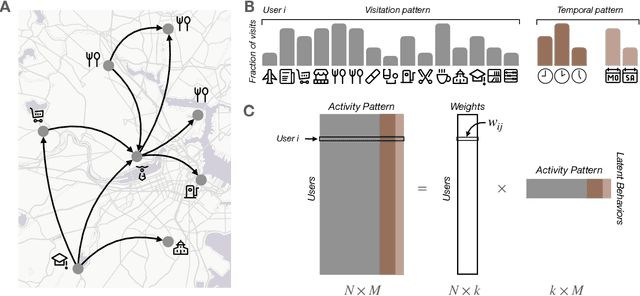
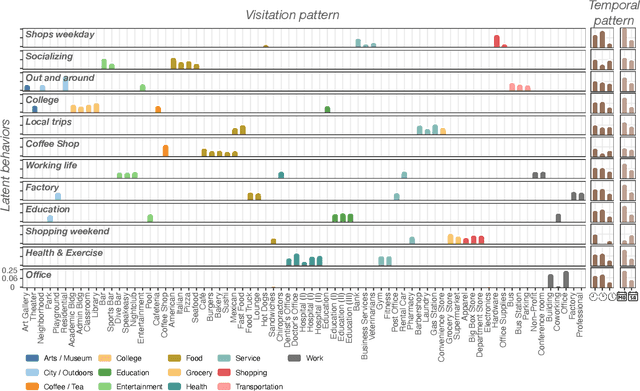
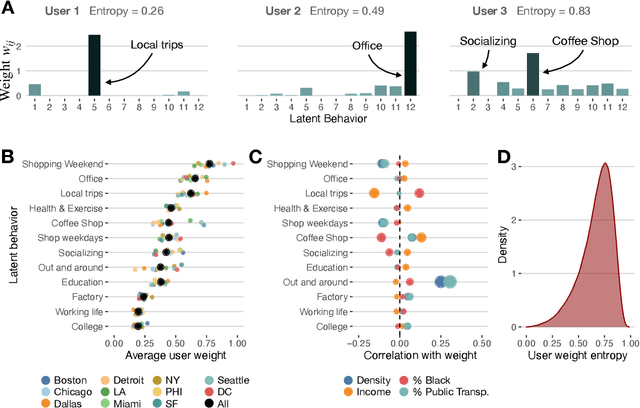
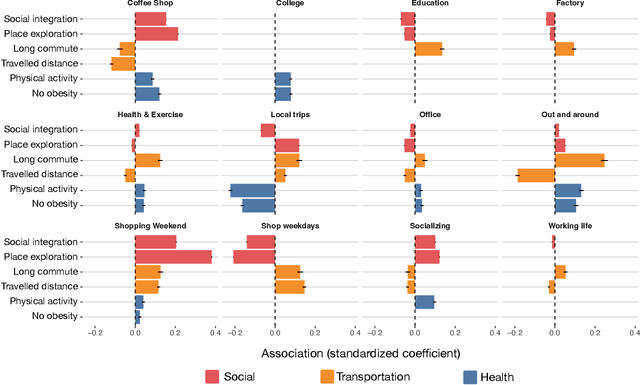
Abstract:Urbanization and its problems require an in-depth and comprehensive understanding of urban dynamics, especially the complex and diversified lifestyles in modern cities. Digitally acquired data can accurately capture complex human activity, but it lacks the interpretability of demographic data. In this paper, we study a privacy-enhanced dataset of the mobility visitation patterns of 1.2 million people to 1.1 million places in 11 metro areas in the U.S. to detect the latent mobility behaviors and lifestyles in the largest American cities. Despite the considerable complexity of mobility visitations, we found that lifestyles can be automatically decomposed into only 12 latent interpretable activity behaviors on how people combine shopping, eating, working, or using their free time. Rather than describing individuals with a single lifestyle, we find that city dwellers' behavior is a mixture of those behaviors. Those detected latent activity behaviors are equally present across cities and cannot be fully explained by main demographic features. Finally, we find those latent behaviors are associated with dynamics like experienced income segregation, transportation, or healthy behaviors in cities, even after controlling for demographic features. Our results signal the importance of complementing traditional census data with activity behaviors to understand urban dynamics.
Private independence testing across two parties
Jul 08, 2022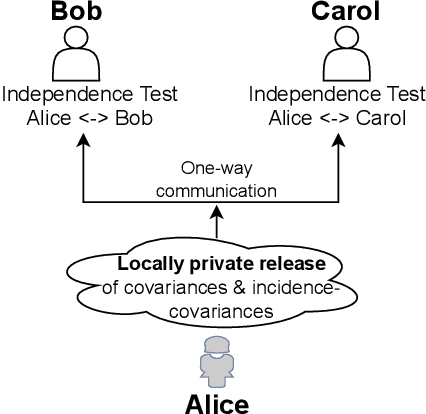
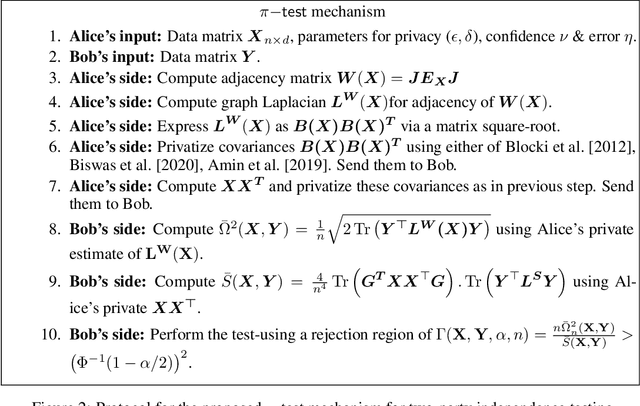
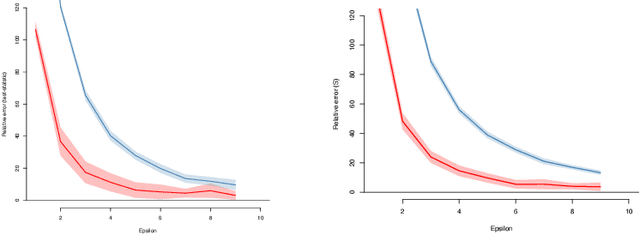
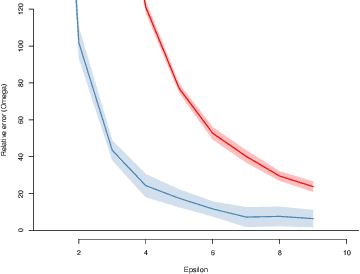
Abstract:We introduce $\pi$-test, a privacy-preserving algorithm for testing statistical independence between data distributed across multiple parties. Our algorithm relies on privately estimating the distance correlation between datasets, a quantitative measure of independence introduced in Sz\'ekely et al. [2007]. We establish both additive and multiplicative error bounds on the utility of our differentially private test, which we believe will find applications in a variety of distributed hypothesis testing settings involving sensitive data.
Private and Byzantine-Proof Cooperative Decision-Making
May 27, 2022
Abstract:The cooperative bandit problem is a multi-agent decision problem involving a group of agents that interact simultaneously with a multi-armed bandit, while communicating over a network with delays. The central idea in this problem is to design algorithms that can efficiently leverage communication to obtain improvements over acting in isolation. In this paper, we investigate the stochastic bandit problem under two settings - (a) when the agents wish to make their communication private with respect to the action sequence, and (b) when the agents can be byzantine, i.e., they provide (stochastically) incorrect information. For both these problem settings, we provide upper-confidence bound algorithms that obtain optimal regret while being (a) differentially-private and (b) tolerant to byzantine agents. Our decentralized algorithms require no information about the network of connectivity between agents, making them scalable to large dynamic systems. We test our algorithms on a competitive benchmark of random graphs and demonstrate their superior performance with respect to existing robust algorithms. We hope that our work serves as an important step towards creating distributed decision-making systems that maintain privacy.
Adaptive Methods for Aggregated Domain Generalization
Dec 23, 2021



Abstract:Domain generalization involves learning a classifier from a heterogeneous collection of training sources such that it generalizes to data drawn from similar unknown target domains, with applications in large-scale learning and personalized inference. In many settings, privacy concerns prohibit obtaining domain labels for the training data samples, and instead only have an aggregated collection of training points. Existing approaches that utilize domain labels to create domain-invariant feature representations are inapplicable in this setting, requiring alternative approaches to learn generalizable classifiers. In this paper, we propose a domain-adaptive approach to this problem, which operates in two steps: (a) we cluster training data within a carefully chosen feature space to create pseudo-domains, and (b) using these pseudo-domains we learn a domain-adaptive classifier that makes predictions using information about both the input and the pseudo-domain it belongs to. Our approach achieves state-of-the-art performance on a variety of domain generalization benchmarks without using domain labels whatsoever. Furthermore, we provide novel theoretical guarantees on domain generalization using cluster information. Our approach is amenable to ensemble-based methods and provides substantial gains even on large-scale benchmark datasets. The code can be found at: https://github.com/xavierohan/AdaClust_DomainBed
 Add to Chrome
Add to Chrome Add to Firefox
Add to Firefox Add to Edge
Add to Edge